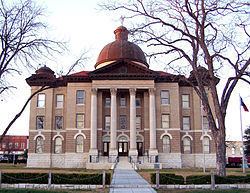Website www.co.hays.tx.us Founded 1848 | Area 1,761 km² Population 176,026 (2013) | |
 | ||
Cities Points of interest Wonder Cave, San Marcos Outlet Ma, Jacob's Well, First United Methodist Church, Old Main | ||
Hays County is a county located on the Edwards Plateau in the U.S. state of Texas. As of the 2010 census, its official population had reached 157,107. The county seat is San Marcos. The county is named for John Coffee Hays, a Texas Ranger and Mexican–American War officer.
Contents
- Map of Hays County TX USA
- History
- Geography
- Major highways
- Adjacent counties
- Demographics
- Education
- Politics
- Cities multiple counties
- Village
- Census designated place
- References
Map of Hays County, TX, USA
Hays County is part of the Austin-Round Rock, TX Metropolitan Statistical Area.
History
Geography
According to the U.S. Census Bureau, the county has a total area of 680 square miles (1,800 km2), of which 678 square miles (1,760 km2) are land and 1.9 square miles (4.9 km2) (0.3%) are covered by water.
Major highways
Adjacent counties
Demographics
As of the census of 2000, 97,589 people, 51,265 households, and 22,150 families resided in the county. The population density was 144 people per square mile (56/km²). The 55,643 housing units averaged 53 per mi2 (20/km2). The racial makeup of the county was 78.92% White, 3.68% Black or African American, 0.69%Native American, 0.79% Asian, 0.07% Pacific Islander, 13.36% from other races, and 2.49% from two or more races. About 29.57% of the population were Hispanic or Latino of any race.
Of the 33,410 households, 34.00% had children under the age of 18 living with them, 53.10% were married couples living together, 9.00% had a female householder with no husband present, and 33.70% were not families; 21.00% of all households were made up of individuals and 4.90% had someone living alone who was 65 years of age or older. The average household size was 2.69 and the average family size was 3.21.
A Williams Institute analysis of 2010 census data found there were about 7.4 same-sex couples per 1,000 households in the county.
In the county, the population was distributed as 24.50% under the age of 18, 20.50% from 18 to 24, 28.20% from 25 to 44, 19.10% from 45 to 64, and 7.70% who were 65 years of age or older. The median age was 28 years. For every 100 females, there were 101.30 males. For every 100 females age 18 and over, there were 99.50 males.
The median income for a household in the county was $45,006, and for a family was $56,287. Males had a median income of $35,209 versus $27,334 for females. The per capita income for the county was $19,931. About 6.40% of families and 14.30% of the population were below the poverty line, including 10.30% of those under age 18 and 9.70% of those age 65 or over.
Education
School districts in Hays county include the San Marcos Consolidated, Dripping Springs Independent, Wimberley Independent, and Hays Consolidated schools. As of 2009, three high schools, five middle schools, and 11 elementary schools are in the county.
Higher education in Hays County includes one four-year institution, Texas State University, in San Marcos. Three Distance Learning Centers are operated by Austin Community College. These centers offer basic and Early College Start classes, along with testing centers for online classes.
Politics
Like the rest of Texas, Hays County was once a strongly Democratic Party leaning county in federal elections, even by Solid South standards. However, like other rural and suburban counties in the state, the county has been leaning towards the Republican Party. The last Democrat to carry Hays County in a presidential election was Bill Clinton with a plurality of 39.8% of the vote in 1992. The last Democrat to win a majority of the vote in the county was Jimmy Carter with 54.4% in 1976. Lloyd Bentsen is the last Democratic senatorial candidate to carry the county, winning 69.2% of the vote in 1988.
The county is no less Republican at the state level. Ann Richards is the most recent Democratic gubernatorial candidate to win the county, having done so in 1990 with 56.6% of the vote.
Democratic strength lies primarily in the city of San Marcos due to the presence of Texas State University. Republican strength lies within the more rural cities of Buda, Kyle, and Wimberley.
